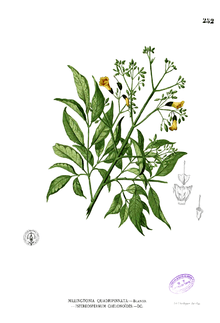Stereospermum chelonoides
| Stereospermum chelonoides | |
|---|---|
 | |
| Scientific classification | |
| Kingdom: | Plantae |
| (unranked): | Angiosperms |
| (unranked): | Eudicots |
| (unranked): | Asterids |
| Order: | Lamiales |
| Family: | Bignoniaceae |
| Genus: | Stereospermum |
| Species: | S. chelonoides |
| Binomial name | |
| Stereospermum chelonoides DC. | |
| Synonyms[1] | |
| |
Stereospermum chelonoides is an deciduous tree native to South Asia.[2]
In Theravada Buddhism, this plant is said to have used as the tree for achieved enlightenment, or Bodhi by third Lord Buddha called "Saranankara - සරණංකර", and twenty second Lord Buddha "Vipassi - විපස්සි". The plant is known as පුලිල (pulila) in Sanskrit, and පලොල් (palol) in Sinhala and পারুল (parul) in Bengali.
References
- ↑ The Plant List: A Working List of All Plant Species, retrieved 16 November 2016
- ↑ Troup, Robert Scott (1921), The silviculture of Indian trees, Clarendon Press, pp. 688–689
External links
This article is issued from
Wikipedia.
The text is licensed under Creative Commons - Attribution - Sharealike.
Additional terms may apply for the media files.